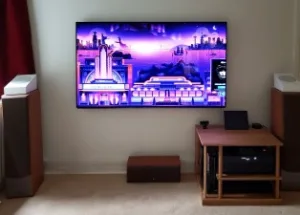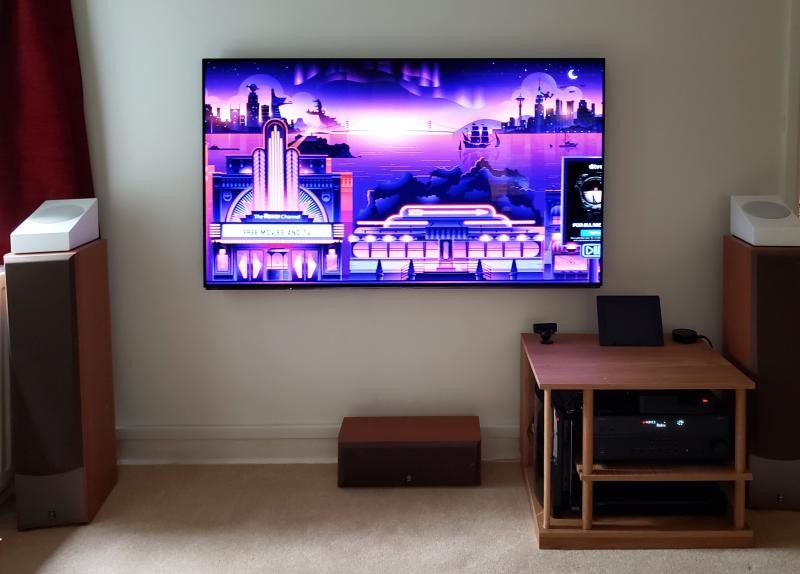I’ve finally upgraded my home TV from my much loved Panasonic PDP (which has found a home elsewhere in the house, where guests will get to enjoy it!). So what did I choose?
My history with TV over the last 30+ years has been
- Hitachi 21″ (I think) 4:3 CRT TV (I wanted to replace it, but it wouldn’t die!)
- Sony 32″ 16:9 Trinitron CRT – much more expensive than I thought was reasonable, but I had just inherited a small amount of money!
(For a long time, I stuck with my Sony and rejected a move to LCD because of the terrible image quality and artefacts of LCDs. I used to set up LCD TVs sent for review just below my CRT to compare side by side. The CRT always looked better. The first LCD TV that I saw that got me starting to watch it, rather than the CRT, was based on one of the very good Sharp PAL P panels. That was in 2005. These panels were available in 26″, 32″ and 37″ sizes, with 960 x 540 panels that looked really good with SD PAL, rather than using an HD panel and then upscaling. What particularly impressed me at the time was the rejection of ambient light. In optimum viewing conditions of very low light, the CRT looked better, but the LCD looked better in most brighter conditions. Unfortunately for Sharp, the European TV set business, with the backing of major retailers, was promoting the ‘HD Ready’ logo programme with considerable success. The Sharp sets couldn’t support the logo, so sets based on the panel disappeared from the market very quickly, which was a shame. For those watching very low bit rate SD images via DTT, they would have been a much better option than HD sets with upscaling, which simply made the compression artefacts more visible.)
- Sony 40″ LCD. I didn’t like the image quality compared to the 32″, but the contrast in higher ambient light (and it was a gift from Sony after some successful analysis and forecasting work with them, so hard not to use it!) The set had pretty good performance, but I was never entirely happy with the motion performance, especially for watching sport.
- Panasonic 50″ PDP. I was doing a lot of work for Panasonic (talks, white papers etc) and I really liked the firm’s commitment to maintaining ‘the creator’s content’. The Panasonic had great video quality (when most of the ‘enhancement’ was turned off. At the time of the end of Panasonic’s PDP business in early 2014, I hoped there might be some ‘end of line’ 65″ bargain sets, but they sold out very quickly and with firm prices, so I didn’t get one.
Over recent years, I have watched as set sizes grew and wanted a new and bigger set and once I had seen HDR, I wanted that as well. I really haven’t liked LCD for TV for a long time and couldn’t bring myself to buy one. The trouble is, I’ve been educated (largely by LG Display, of course!) to recognise the defects of local dimming etc on LCD TVs and I was worried that I would spend all my time watching the artefacts rather than watching the content. (I gave up paying attention to hi-fi a long time ago, for the same reason. I really wanted to listen to the music, not the system!).
So, I wanted to buy an OLED TV, but the Panasonic PDP was still alive and my wife (and family accountant!) was reluctant to go to a bigger set. However, we were re-decorating the lounge and I was able to convince her that by carefully mounting the TV on the wall, and by applying some woodworking skills to make a new cabinet for the sound system, STB and old games console, I could actually give her back quite a lot of floor space and tidy up the messy tangle of wires. At the same time, I could upgrade to a bigger size.
It was a horrible job, as all the wiring had to be in a conduit in the wall because of the wiring regulations in the UK and I got through several different HDMI cables trying to get a good quality one that would fit the conduit, but eventually, it got done and it is a lot neater and takes up less floor space, so that was a win!
Anyway, I settled on a 65″ Panasonic GZ950 OLED and was able to get a good deal on the best value model from last year that had received a very positive review from Vincent Teoh of HDTV Test, and who I trust to say it as he sees it! I got a good deal from UK reseller Richer Sounds and placed my order.
Over the years, I have seen dozens of demos of OLEDs from Panasonic, LG Display and others. However, the viewing conditions are usually very optimised, so I was a little nervous when the set arrived, in case in our regular household conditions it didn’t look so good. I shouldn’t have worried. The set has spectacular image quality, especially from Blu-ray content. The black level and motion performance are really great. Upscaling really makes the differences between UltraHD and native FullHD content quite marginal at my normal viewing distance. Although the peak brightness is quite a bit lower than the best LCDs, in low lighting (which is how I usually watch), the OLED has plenty of brightness.
I remain a little nervous about image burn in, but the technology designed to mitigate the effects, such as reducing the brightness of fixed logos, seems to be doing a good job. Somebody said to me “Did you have a problem with your PDP and burn-in? Why do you expect a problem with an OLED?”. It was a good question, and I’m happy to say “so far, so good”.
Readers can be confident that if I find an issue with burn-in, I will report it in detail! (BR)


